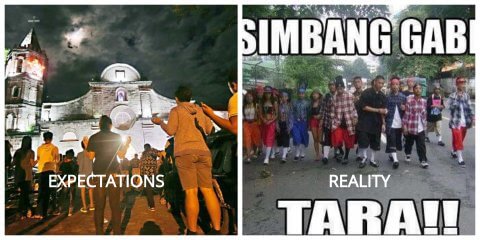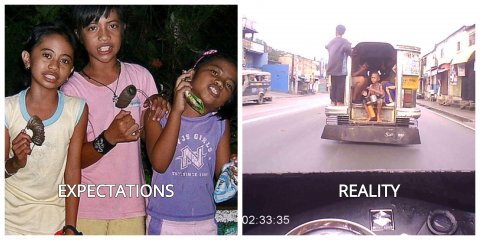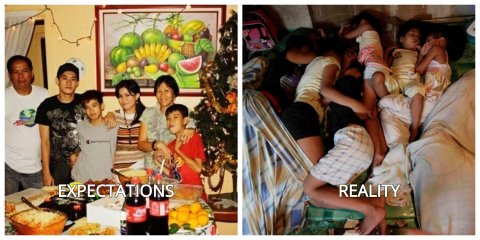Christmas traditions in the Philippines could be considered as the best in the world. They are warm, family, and God-centered and, most of all, the longest.
For Filipinos, the Christmas season is expected to be the “most wonderful time of the year.” However, the holidays celebrated in the country is not always what we imagined or experienced it to be. So here are Christmas traditions’ expectations and reality, which can help you prepare.
Christmas Philippines Traditions: Expectations vs. Reality
1. “Ber Months”
What is it: “Ber Months” are months ending in “ber,” hence the name. It begins in September and ends in December. It marks the beginning of the Christmas season in the country.
Expectations: Filipinos begin decorating houses, malls, establishments, or wherever they with Christmas ornaments such as Christmas lights, parols or lanterns, and nativity scenes. You will also start hearing yuletide carols on the radio or at shopping malls.
Reality: Christmas begins as early as July and usually ends by January after the celebration of Three Kings celebrated on the First Sunday of January. It is also known as the Pasko ng Matatanda (Feast of the Elderly) or day to honor the senior citizens.
Memes showing Josie Marie Chan counting down when he would sing “Christmas in Our Hearts” would flood your Facebook wall by August.

Christmas decorations are commonly taken down by February, wherein they replace it with hearts and cupids to celebrate Valentine’s day.
2. Misa de Gallo or Simbang Gabi
What is it: It is a devotional nine-day series of Masses practiced by Filipino Catholics and Aglipayans. It is held daily from December 16–24 and occurs at different times ranging from as early as 03:00 to 05:00 am. A well-known folk belief among the Filipinos is that if a devotee completed all nine days of the Simbáng Gabi, a request made as part of the novena might be granted.
Expectations: Everybody is at the church early, praying, and worshipping God. The whole family will eat bibingka, (rice cakes cooked above and below) and puto bumbong (steamed purple rice pastries, seasoned with butter, grated coconut, and brown sugar) are famous, often paired with tsokolate (hot chocolate from local cacao) or salabát (ginger tea) together.

Reality: Gone are the days that children and young people would wake up early, dress up, and attend the mass. Also, don’t be surprised if you’ll see church attendees violating church’s dress code such as micro mini skirts, skimpy shorts or sleeveless shirts, caps, and basketball jerseys. You might also young couples dating while the priest is preaching. We pray to see any Gen Z whose not glued to their phone the whole sermon.
Christmas Philippines Traditions: Expectations vs. Reality
3. Christmas Caroling
What is it: Children in small groups go from house to house singing Christmas carols, which they called pangangaroling.

Expectations: Children carolers are happy and would make makeshift instruments like tambourines made with aluminum bottle caps strung on a piece of wire. They would chant “Namamasko po!” and would wait expectantly for the homeowners to reward them with coins. Afterward, the carolers thank the generous homeowners by singing, “Thank you, thank you, ang babait ninyo (you are so kind), thank you!”
Reality: Children are still caroling, but mostly on the streets begging. According to reports, the holidays are considered the peak season for street children who were asking for money from strangers. Some are creative enough to use makeshift drums and perform trendy beats, especially the Badjaos.
Caroling in the Philippines also leveled-up. Many use portable speakers, a whole band, and even artistically choreographed dances. They also use envelopes, so it might be a bit embarrassing to give coins.
4. Giving Aguinaldo
What is it: Aguinaldo is a Spanish term for a bonus. These are people, especially godparents, give gifts or money to children, employees, or anyone in general.
Expectations: Children with their parents would go to their godparents’ houses where they make mano (putting someone’s hand on your forehead). It is an “honoring-gesture” performed as a sign of respect to elders and as a way of requesting a blessing from the elder. The children’s parents and the godparents would bond together over Noche Buena’s leftovers.

Reality: Not only children nowadays do not know how to “bless” or mano; it appeared they are hard to please. Most children now would expect at least a crisp P100 of five P20 bills from their godparents. Some would even complain or throw a tantrum if they would only get simple a toy or P50. But the worsts are the entitled kumadres and kumpadres demanding godparents to sent a minimum amount of aguinaldo via money transfer and can’t accept no if their request is not granted. The result? Friendship over.
5. Noche Buena
What is it: Noche Buena is the Spanish word for “night of goodness” wherein Filipino families gather together and eat during Christmas Eve.
Expectations: The whole family gathered together at the dining table by midnight to welcome the birth of Jesus Christ. Noche Buena menu includes pancit (Filipino fried noodles) for long life, different kakanin (sticky rice dessert) for family unity, and traditional “Tasty” or loaf bread. It is also the time that each member of the family would exchange gifts.

Reality: At least 20% of 108,116,615 Filipinos are experiencing poverty and would probably sleep during Noche Buena. Even the middle-class families opt to skip the tradition and reserve their budget for Media Noche, which is on New Year’s eve. The menu also became more western, which includes spaghetti, Christmas ham, and fried chicken though they still have a touch of Filipino flavors.
What Christmas traditions in the Philippines you think changed? Comment them below.
